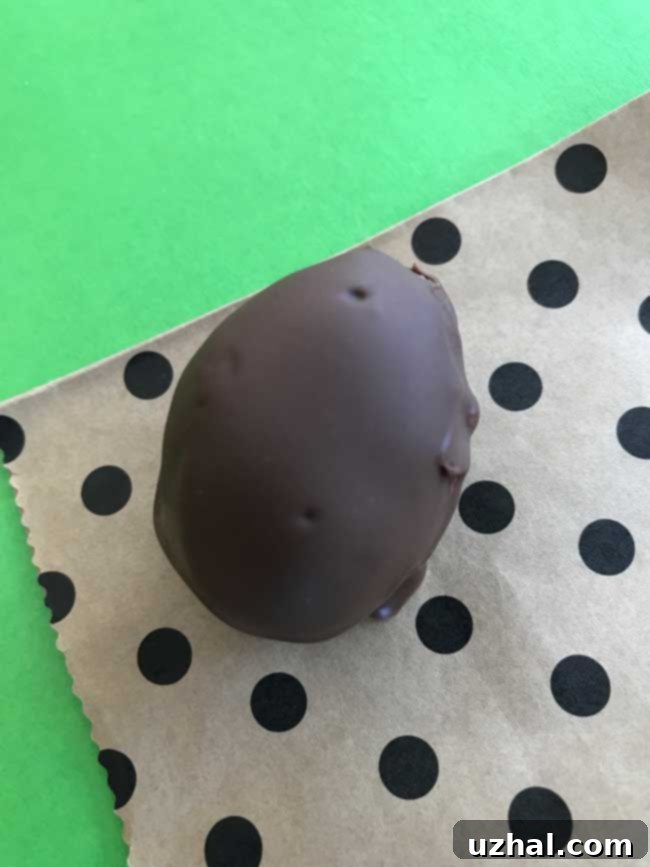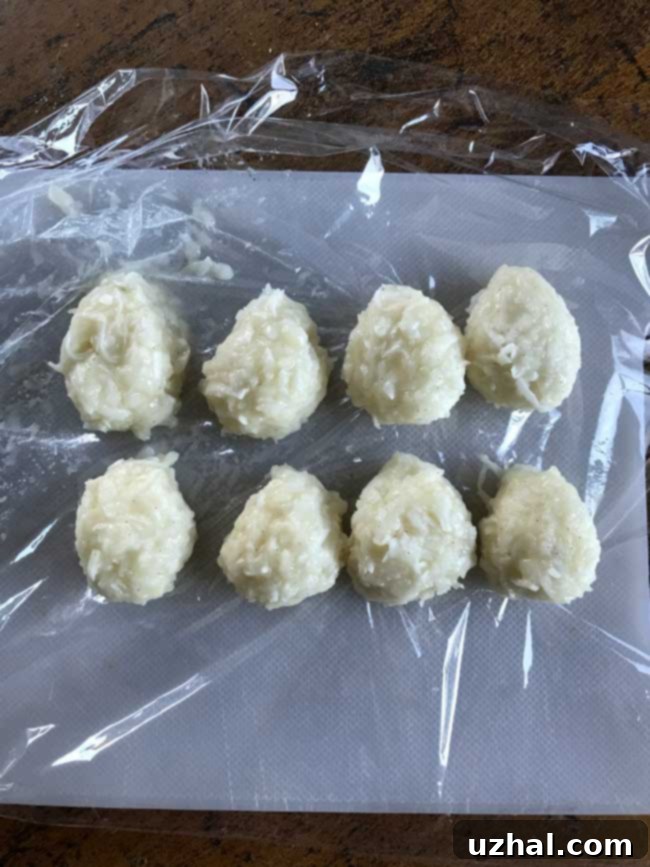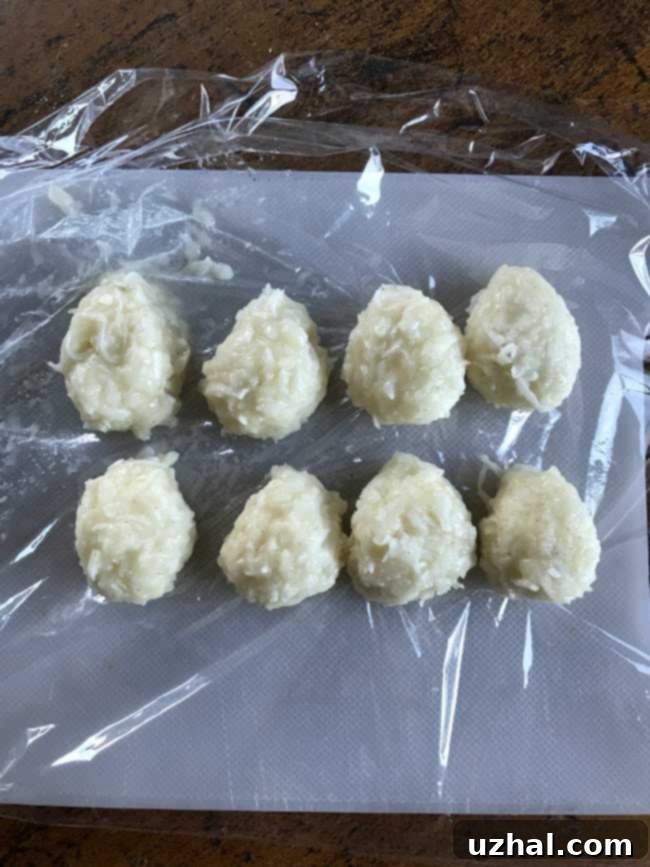Unveiling the Secret: Homemade Pennsylvania Dutch Chocolate Covered Coconut Eggs with a Potato Twist
Easter brings with it a delightful array of traditions, and for many, that includes indulging in homemade treats. Among the most cherished and unique regional confections are the Pennsylvania Dutch chocolate-covered coconut eggs. These aren’t just any coconut eggs; they harbor a surprising secret ingredient that lends them an incredibly smooth texture and rich flavor: the humble potato.
Months ago, my friend Louise shared this fascinating recipe with me, and I knew it was a story (and a taste) worth sharing. This isn’t just a recipe; it’s a piece of culinary history, a testament to clever resourceful cooking, and a delightful journey back to childhood memories for many in Eastern Pennsylvania. Get ready to discover the magic behind these unique Easter delights.

A Taste of Tradition: The Pennsylvania Dutch Legacy
In Eastern Pennsylvania, these coconut eggs are more than just candy; they’re a beloved cultural staple, especially around Easter. Local church groups often craft and sell them by the dozen as fundraisers, making them an eagerly anticipated part of the holiday season. Louise, like many others from the region, holds fond memories of making these distinctive treats with her mother, often alongside their peanut butter counterparts.
The use of potato in candy might sound unusual to the uninitiated, but it’s a brilliant example of Pennsylvania Dutch ingenuity. Historically, potatoes were a readily available and inexpensive crop, making them a resourceful ingredient to extend and enrich recipes. In these candies, the potato acts as a natural binder, adding moisture and creating an incredibly smooth, almost fudge-like consistency to the coconut filling without imparting any noticeable potato flavor. It’s this clever culinary trick that sets these chocolate-covered coconut eggs apart from others.
Louise’s Culinary Journey: Adapting a Beloved Recipe
Last year, Louise decided it was time to rekindle this cherished family tradition by making the coconut eggs herself. While she didn’t have the original recipe on paper, a quick online search led her to an old recipe that seemed to capture the essence of what she remembered. Despite a rather scathing review from one user who declared them “ABSOLUTELY INEDIBLE!”, Louise recognized the fundamental idea was sound. Armed with her memories and a keen understanding of the flavors, she embarked on adapting it.
Her goal was to refine the ingredient ratios and clarify the instructions to ensure a perfect batch every time. The result is the meticulously adapted recipe you’ll find below. Louise’s dedication to perfecting this nostalgic treat is a testament to the power of home cooking and the joy of recreating beloved family traditions. She encourages everyone to try her adapted version and share their thoughts – constructive criticism is always welcome!

The Secret Ingredient Unveiled: Why Potato Works Wonders
Before we dive into the recipe, let’s address the star secret ingredient: the potato. Many recipes for coconut eggs or other confections might call for cream cheese, but Louise emphasizes that this significantly alters the flavor profile, often masking the delicate coconut taste. The potato, on the other hand, is a neutral canvas. When properly cooked and mashed, it contributes a remarkably smooth texture and essential moisture without adding any discernible potato flavor. It helps bind the confectioners’ sugar and coconut into a firm, yet tender, filling that holds its shape beautifully and melts delightfully in your mouth.
This use of potato also draws parallels to other traditional potato candies, such as “Needhams” from Maine, which are chocolate-covered potato and coconut confections. While the exact regional origins differ, the core concept of using potato for a creamy, dense filling remains a clever and effective culinary technique.
Classic Pennsylvania Dutch Chocolate Covered Coconut Easter Eggs (aka Needhams or Potato Candy)
This recipe provides the perfect balance of sweetness and rich coconut flavor, enhanced by the unique texture from the potato. Pay close attention to cooling the potato for the best results!
Ingredients:
- 1 medium potato (approximately 6 to 8 oz before cooking, cooked to yield about ¾ cup unseasoned, smooth mashed potatoes)
- 2 cups unsweetened dried coconut (flaked or shredded)
- ¼ teaspoon salt
- 1 teaspoon vanilla extract (pure vanilla is recommended for best flavor)
- 1 ½ pounds confectioners’ sugar (powdered sugar), which is roughly 6 cups, sifted if clumpy
- 12 ounces dark chocolate (good quality baking chocolate, chips, or bars)
- 1 teaspoon vegetable oil (optional, for shine and easier dipping)
Preparation Instructions:
- Prepare the Potato: Begin by cooking your potato until it is very tender. Peel it and mash it thoroughly until absolutely no lumps remain. A potato ricer or food mill can achieve the smoothest results, but careful mashing with a fork or masher will also work. This is a critical step: ensure the mashed potato is allowed to cool completely to room temperature before proceeding. Using warm potato will melt the sugar, leading to a much stickier mixture that requires excessive sugar to firm up, resulting in an overly sweet and less desirable candy.
- Combine Wet Ingredients: In a large mixing bowl, combine the thoroughly cooled mashed potatoes, unsweetened dried coconut, salt, and vanilla extract. Use a hand mixer on low speed or a sturdy spatula to blend these ingredients together until well incorporated.
- Incorporate Confectioners’ Sugar: Begin adding the confectioners’ sugar, one cup at a time, mixing well after each addition. The first cup of sugar will start to draw out moisture from the potato, making the mixture a bit wetter before it begins to thicken. Continue adding sugar gradually until the mixture becomes slightly stiff and pliable enough to hold its shape when pressed. It shouldn’t be overly dry, as the coconut will continue to absorb some liquid as it rests. The exact amount of sugar might vary slightly depending on the moisture content of your potato, so trust your judgment for texture.
- Chill the Filling: Once the mixture reaches the desired consistency, cover the bowl tightly with plastic wrap and refrigerate it overnight. This chilling period is crucial as it allows the flavors to meld, the coconut to fully hydrate, and the mixture to firm up perfectly for shaping.
- Shape the Eggs: The following day, remove the filling from the refrigerator and let it come to room temperature for about 15-20 minutes, which makes it easier to handle. Using a small cookie scoop or a tablespoon, portion out the mixture and roll it gently between your palms into egg shapes. Aim for uniform sizes for consistent dipping and appearance. Place the formed eggs on a baking sheet lined with waxed paper or parchment paper.
- Prepare the Chocolate for Dipping: In a microwave-safe bowl or a double boiler, gently melt the dark chocolate. If using the microwave, heat in 30-second intervals, stirring well after each, until smooth. If using the optional vegetable oil, stir it into the melted chocolate. The oil not only adds a beautiful subtle shine but also helps to thin the chocolate slightly, making it easier to dip and ensuring a smoother coating.
- Dip the Coconut Eggs: This step requires a bit of technique for a clean finish. Place one coconut egg on a fork, submerging it completely into the melted chocolate. Lift the egg, tapping the fork gently against the side of the bowl to allow excess chocolate to drip off. This helps prevent pools of chocolate from forming at the base of your eggs. Carefully slide the chocolate-covered egg onto the prepared waxed or parchment paper. Repeat with the remaining eggs.
- Harden and Serve: Allow the chocolate-covered eggs to set at room temperature or, for faster hardening, place them in the refrigerator for about 15-30 minutes. Once the chocolate is firm, these delectable treats are ready to be enjoyed! Store any leftovers in an airtight container in a cool, dry place or in the refrigerator.
Using Sweetened Coconut: An Alternative Approach
While Louise’s recipe, using unsweetened coconut, is truly exceptional and captures the authentic Pennsylvania Dutch flavor profile, it’s worth noting that these coconut eggs can also be made with sweetened flaked coconut if that’s what you have on hand or prefer. My own note on this variation, which often caters to different taste preferences, allows for a slightly different, perhaps more readily available, ingredient choice.
When opting for sweetened coconut, you’ll need to adjust the quantities of other ingredients, particularly the confectioners’ sugar, to account for the sugar already present in the coconut. The sweetness level will naturally be higher, and the texture might be subtly different, but the core essence of the delicious potato-infused coconut filling remains.
Anna’s Variation for Sweetened Coconut:
- ¾ cup unseasoned mashed potatoes (fully cooled)
- 4 cups sweetened flaked coconut
- 4 cups confectioners’ sugar
- ½ teaspoon salt
- About 1 ½ teaspoons vanilla extract
The method for preparing and dipping these eggs remains the same as described in Louise’s original recipe. Simply combine the cooled mashed potatoes, sweetened coconut, salt, and vanilla, then gradually add the confectioners’ sugar until a firm, pliable mixture is achieved. Chill overnight, shape, and dip in your favorite melted chocolate. This variation offers a convenient and equally delicious option for those who prefer the enhanced sweetness and common availability of sweetened coconut.
Tips for Success and Creative Variations
- Don’t Rush the Cooling: The importance of thoroughly cooling the mashed potato cannot be overstated. Warm potato will make your mixture runny and overly sweet.
- Quality Chocolate Matters: Using good quality dark chocolate for dipping will significantly enhance the overall flavor and provide a better snap and shine.
- Experiment with Extracts: While vanilla is classic, consider adding a touch of almond extract for a different flavor dimension.
- Decorate for Fun: Before the chocolate sets, you can sprinkle the eggs with colorful sprinkles, shredded coconut, or a drizzle of contrasting white chocolate for an extra festive touch.
- Storage: Store the finished eggs in an airtight container in a cool, dry place for up to a week, or in the refrigerator for even longer freshness.
These homemade chocolate-covered coconut eggs, with their surprising secret ingredient, offer a unique and delightful treat that’s steeped in tradition. They’re a perfect project for Easter or any time you crave a truly special homemade candy. Give Louise’s adapted recipe a try, and you might just discover your new favorite sweet indulgence!
